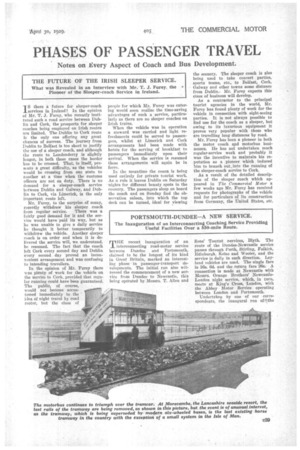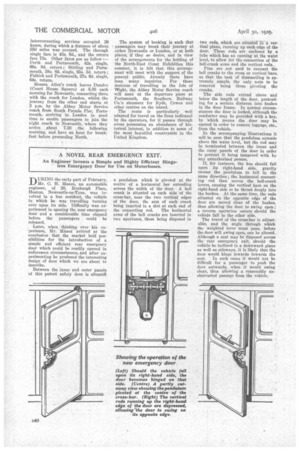PHASES OF PASSENGER TRAVEL
Page 69

Page 70

If you've noticed an error in this article please click here to report it so we can fix it.
IS there a future for sleeper-coach services in Ireland? In the opinion of Mr. T. J. Furey, who recently instituted such a road service between Dublin and Cork, the prospects for sleeper coaches being employed on Irish routes are limited. The Dublin to Cork route is the only one offering any great chances of success. The journey from Dublin to Belfast is too short to justify the use of a sleeper coach, and although the route to Londonderry is slightly longer, in both these cases the border has to be crossed. That, in itself, presents a great difficulty, as the vehicles would be crossing from one state to another at a time when the customs officers are not on duty. There is no demand for a sleeper-coach service between Dublin and Galway, and Dublin to Cork, via Limerick, is the only important route left.
Mr. Furey, to the surprise of many, recently withdrew his sleeper coach from regular service. There was a fairly good demand for it and the service would have paid its way, but as he was unable to give a daily service he thought it better temporarily to withdraw the vehicle. Another sleeper coach is on order and when it is delivered the service will, we understand, be resumed. The fact that the coach left Cork every second day and Dublin every second day proved an inconvenient arrangement and was confusing to intending travellers.
In the opinion of Mr. Furey there was plenty of work for the vehicle on the service to Cork, provided that regular running could have been guaranteed. The public, of course, would not become accustomed immediately to the idea Of night travel by road motor, but the class of people for which Mr. Furey was catering would soon realize the time-saving advantages of such a service, particularly as there are no sleeper coaches on Irish trains.
When the vehicle was in operation a steward was carried and light refreshments could be served to Passengers, whilst at Limerick and Cork arrangements bad been made with hotels for the serving of breakfast to passengers immediately upon their arrival. When the service is resumed these arrangements will again be in force.
In the meantime the coacn is being used entirely for private tourist work. As a rule it leaves Dublin on Saturday nights for different beauty spots in the country. The passengers sleep on board the coach and on Sunday find the observation saloon, into which the top deck can be turned, ideal for viewing
THE recent inauguration of an interconnecting road-motor service between Dundee and Portsmouth, claimed to be the longest of its kind in Great Britain, marked an interesting phase ' in passenger-transport developments. The initial run also witnessed the commencement of a new service from Dundee to Newcastle, this being operated by Messrs. T. Allen and
the scenery. The sleeper coach is also being used to take concert parties, sports teams, etc., to Belfast, Cork, Galway and other towns some distance from Dublin.. Mr. Furey expects this mass of business will develop.
As a contractor to the principal tourist agencies in the world, Mr. Furey has found plenty of work for the vehicle in connection with sight-seeing parties. It is not always possible to find use for the coach as a sleeper, but owing to its luxurious equipment it proves very popular with those who are travelling long distances by road.
Mr. Furey has been a pioneer iii both the motor coach and motorbus businesses. He has not undertaken much regular-service work and probably it was the incentive to maintain his reputation as a pioneer which induced him to branch out.into the running of the sleeper-coach service to Cork.
As a result of the detailed description of the sleeper coach which appeared in The Commercial Motor a few weeks ago Mr. Furey has received requests for photographs of the vehicle and for particulars of its construction from Germany, the United States, etc.
Sons' Tourist services, Blyth. The route of the Dundee-Newcastle service passes through Perth, Stirling, Falkirk, Edinburgh, Kelso and Wooler, and the service is daily in each direction. Leyland vehicles are used. The single fare is 16s. 6d. and the return fare 26s. A connection is made at Newcastle with Messrs. Orange Brothers' NewcastleLondon night service, which, in turn, meets at King's Cross, London, with the Abbey Motor Service operating between London and Portsmouth.
Undertaken .by one of our correspondents, the inaugural run ofOthe interconnecting services occupied 29 hours, during which a distance of about 550 mites was covered. The through single fare is 43s. 6d., and the return fare 73s. Other fares are as follow :Perth and Portsmouth, 42s. single, 69s. na. return ; Stirling and Portsmouth, 38s. lid. single, 65s. 2d. return; Falkirk and Portsmouth, 37s. 6d. single, 64s. return.
Messrs. Allen's coach leaves Dundee (Court House Square) at 8.30 each morning for Newcastle, connecting there with the coach for London, whilst the journey from the other end starts at 2 p.m. by the Abbey Motor Service coach from South Parade Pier, Portsmouth, arriving in London in good time to enable passengers to join the night coach to Newcastle, where they arrive about 720 the following morning, and have an hour for breakfast before proceeding North.
DURING the early part of February, Mr. C. H. Mason, an automobile engineer, of 20, Roxburgh Place, Heaton, Neweastle-on-Tyne, was involved in a bus accident, the vehicle in which he was travelling turning over upon its side. Difficulty was experienced in opening the rear emergency door and a considerable time elapsed before the passengers could be released.
Later, when thinking over his experience, Mr. Mason arrived at the conclusion that the market held possibilities for the introduction of a simple and efficient rear emergency door which could be readily opened in unforeseen circumstances, and after experimenting he produced the interesting design of door which we are about to describe.
Between the inner and outer panels of this patent safety door is situatell
The system of booking is such that passengers may break their journey at either Newcastle or London, or at both places, if they so desire, and in view of the arrangements for the holding of the North-East Coast Exhibition this summer, it is felt that this arrangement will meet with the support of the geners1 public. Already there have been many inquiries. For those desirous of travelling to the Isle of Wight, the Abbey Motor Service coach will meet at the departure piers at Portsmouth, the Southern Railway Co.'s steamers for Hyde, Cowes and other centres on the island.
The route is particularly well adapted for travel on the lines indicated by the operators, for it passes through areas possessing an abundance of historical interest, in addition to some of the most beautiful countryside in the United Kingdom.
a pendulum which is pivoted at the centre of a horizontal bar extending across the width of the door. A bell crank is situated on each side of the cross-bar, near the two vertical edges of the door, the arm of each crank being inserted in a slot at each end of the connecting rod. The horizontal arms of the bell cranks are inserted in two apertures, these being disposed in two rods, which are situated a ver
tical plane, running up each edge of the door. These rods are enclosed by a tube which has an opening at the waist level, to allow for the connection of the bell-crank arms and the vertical rods.
Pins are not used to connect the bell cranks to the cross or vertical-bars, so that the task of dismantling is extremely simple, the only nuts to be removed being those pivoting the cranks.
The side rods extend above and below the length of the door, protruding for a certain distance into bushes in the door frame. In normal circumstances the door is locked, although the conductor may be provided with a key, by which means the door may be opened in order to remove luggage, etc., from the vehicle.
In the accompanying illustrations it will be seen that the pendulum extends above the waist level, but the rod may be terminated between the inner and the outer panels of the door in order to prevent it being tampered with by any unauthorized person.
If, for instance, the bus should fall upon its right-hand side, gravity causes the pendulum to fall in the same direction ; the horizontal connecting rod then moves the bell-crank levers, causing the vertical bars on the right-hand side to be thrust deeply into the bushes. At the same time, the rods situated on the opposite edge of the door are moved clear of the bushes, thus allowing the door to swing open ; a reverse operation occurs should the vehicle fall to the other side.
The travel of the cross-bar is adjustablo, and the angle through which the weighted lever must pass, before the door will swing open, can be altered. Although a seat may be disposed across the rear emergency, exit, should the vehicle be inclined in a downward plane as well as sideways, it is likely that the door would hinge inwards towards the seat. In such cases it would not be difficult for a passenger to push the door outwards, when it would swing clear, thus allowing a reasonably unobstructed passage from the vehicle.




























































































































